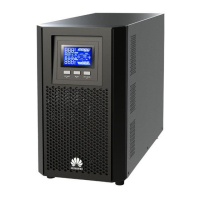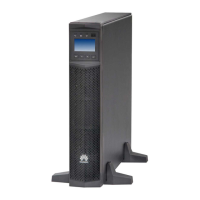UPS5000-A-30 kVA & 40 kVA & 80 kVA
User Manual
Copyright © Huawei Technologies Co., Ltd.
5.6.3 Capacity Test
Context
Before conducting a capacity test, check whether the requirements of a capacity test are met.
If the requirements are met, the button for starting a capacity test is available. Otherwise, the
button is unavailable.
Before a capacity test, ensure that:
The UPS is working in normal mode; float charging or hibernation has lasted for 2 hours
after the state of charge (SOC) reaches 100%; and the load ratio fluctuation is less than
10%.
The UPS has generated no battery overtemperature, overvoltage, or overcurrent alarm. No
generator is connected to the UPS.
The mains, batteries, charger, and discharger are normal. No overload alarm is generated.
Procedure
Step 1 Log in to the WebUI.
Step 2 On the Monitoring > Control > System Commands and Tests page, click Start next to
Capacity test to start a capacity test.
Figure 5-11 Starting a capacity test
Click Stop next to Capacity test in any of the following cases:
The battery discharge voltage reaches the end of discharge (EOD) voltage plus 0.01 V.
The load fluctuation exceeds 10%.
An alarm is generated.
When the battery discharge voltage reaches the EOD voltage plus 0.01 V, the test is complete. The test
data is used as capacity test data. Save the capacity test data record with the largest discharge capacity in
a month as the capacity test data for the month. A maximum of recent 36 capacity test records can be
saved.

